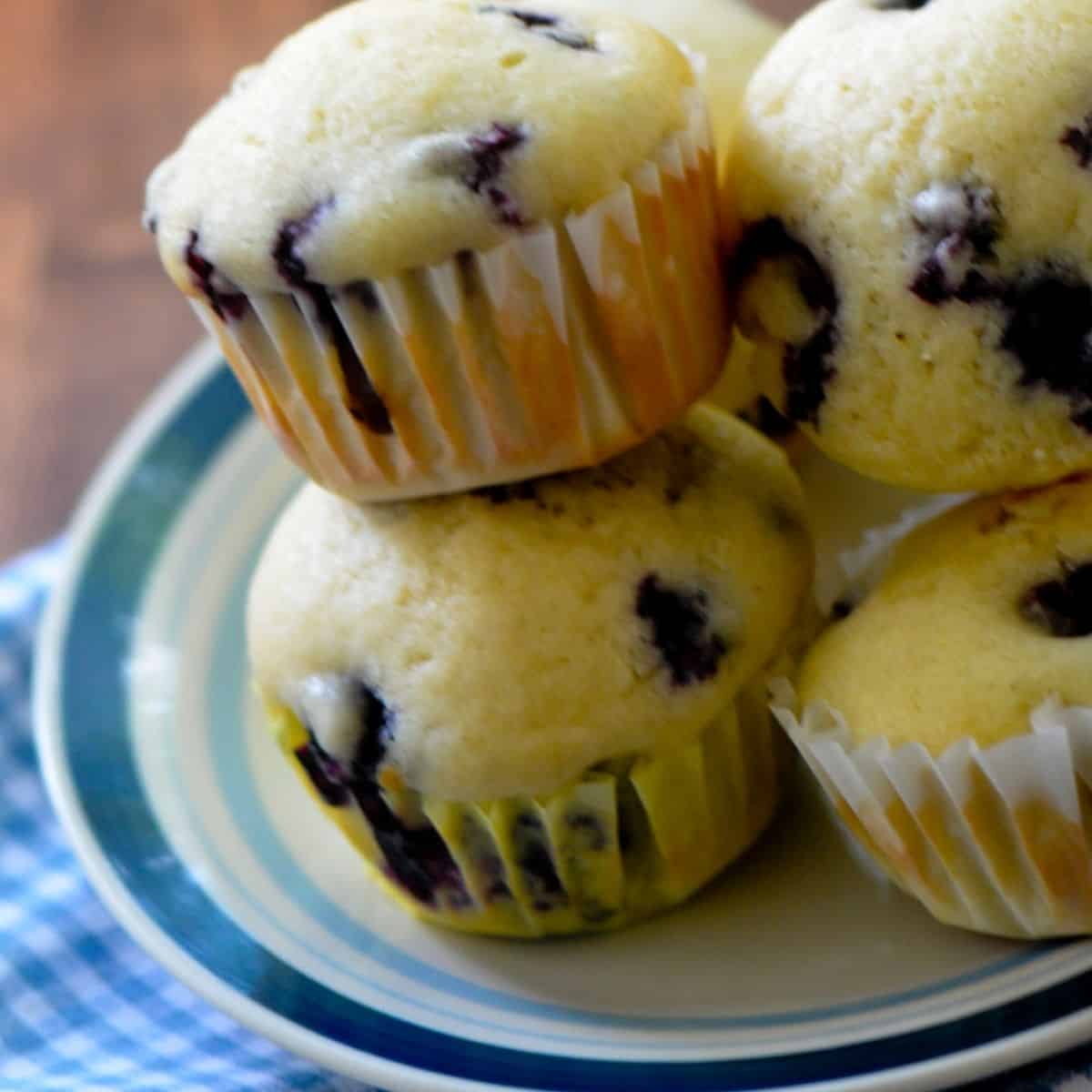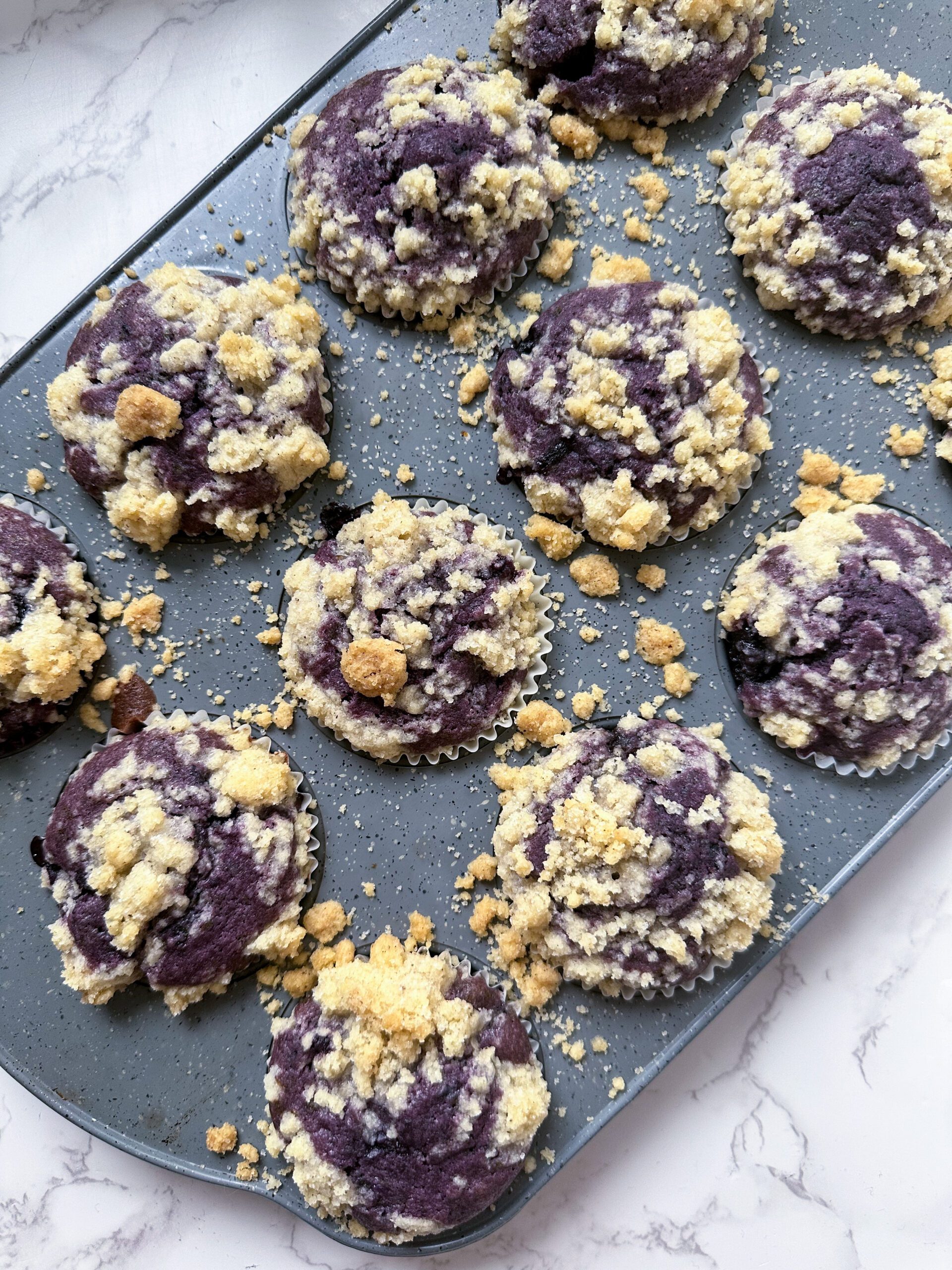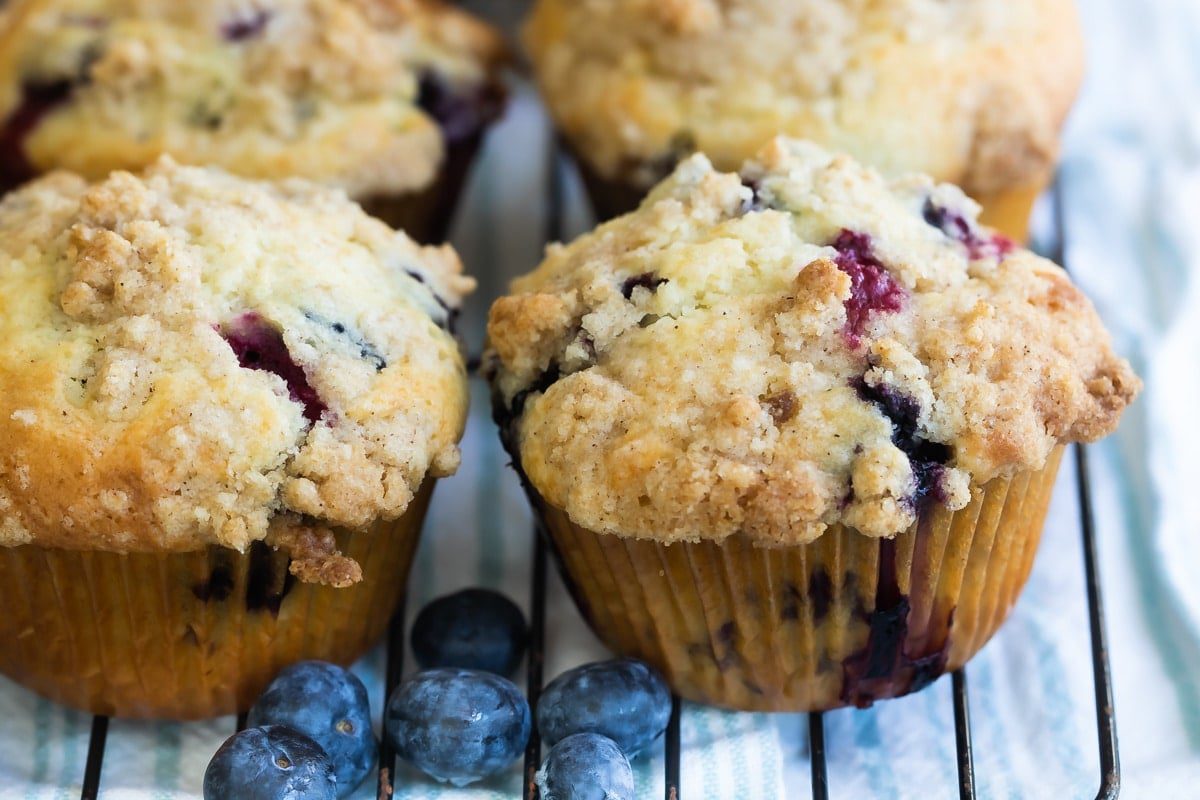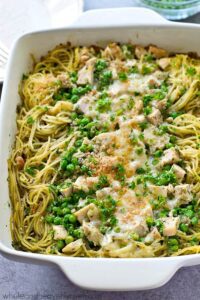The Ultimate Blueberry Muffin is a delicious recipe that combines amazing flavors and textures.
The ultimate blueberry muffin represents the pinnacle of breakfast pastry perfection – a tender, cake-like crumb bursting with juicy berries, crowned with a sweet, crisp topping that gives way to moist interior. What separates exceptional blueberry muffins from merely good ones lies in the details: the method of incorporating berries to prevent sinking and coloring the batter, the creaming technique that creates lightness, and the balance of sweetness that allows the natural flavor of blueberries to shine through.
These muffins achieve textbook perfection through the classic creaming method, which incorporates air into the butter and sugar for optimal rise and tenderness. The distribution of berries is even throughout without concentrating at the bottom, thanks to the simple flour-dusting technique. The optional streusel topping provides contrasting texture and buttery sweetness that complements the tart berries, while the lemon glaze option adds bright acidity that cuts through the richness. When baked correctly, these muffins dome beautifully with craggy tops that are visually appealing and texturally interesting.
The History of the Blueberry Muffin
Blueberries are one of the few fruits native to North America, with Indigenous peoples harvesting and preserving them for centuries. Early European colonists learned about blueberries from Native Americans and incorporated them into puddings, cakes, and eventually muffins as baking traditions developed. The muffin itself has British origins, deriving from the French word “moufflet” meaning soft bread, but the specific blueberry muffin is a distinctly American creation.

Commercial cultivation of blueberries began in the early 20th century, making them more widely available and popular in baked goods. The blueberry muffin gained particular prominence in the 1950s and 1960s as coffee culture and breakfast pastries became increasingly popular. Today, it remains one of the most beloved muffin varieties, representing comfort, simplicity, and the taste of summer regardless of the season.
Ingredient Selection Guide
Blueberries: Fresh blueberries are ideal when in season, but frozen work well too (do not thaw before using). Wild blueberries are smaller and distribute more evenly throughout the batter. If using frozen, toss with flour while still frozen to prevent excessive bleeding. Avoid overhandling the berries to prevent breakage.
Flour: All-purpose flour provides the right structure. For lighter muffins, you can substitute 1/4 cup with cornstarch. Whole wheat pastry flour can replace up to half the all-purpose flour for added nutrition while maintaining tenderness.

Butter: Use high-quality unsalted butter for the best flavor. The butter should be properly softened (65-67°F) for optimal creaming. If using salted butter, reduce the added salt by 1/4 teaspoon.
Dairy: Whole milk provides the richest flavor, but any milk will work. For extra tenderness, you can substitute buttermilk or sour cream for the milk, reducing the baking powder to 2 teaspoons and adding 1/2 teaspoon baking soda.
The Science of the Creaming Method
The creaming method is crucial for developing the ideal muffin texture. Creaming butter and sugar incorporates tiny air bubbles that expand during baking, creating lift and lightness. The sugar crystals cut through the butter, creating pockets that trap air. Proper creaming requires softened butter (not melted) and 3-4 minutes of beating until the mixture becomes pale and fluffy.

Adding eggs one at a time allows proper emulsification. The yolks contain lecithin, which helps bind fat and water molecules, while the proteins provide structure. Overbeating after adding eggs can cause the emulsion to break, resulting in dense muffins.
The alternating addition of dry and wet ingredients prevents overmixing while ensuring even distribution. Beginning and ending with flour helps maintain structure. Mixing until just combined is essential – overmixing develops gluten, resulting in tough muffins with peaked tops and tunnels in the crumb.
Berry Distribution Techniques
Preventing blueberries from sinking requires several strategies. Tossing them with a tablespoon of flour from the measured amount helps coat them so they suspend better in the batter. The flour coating also absorbs some of the berry juice, reducing purple streaking.
Folding the berries in gently at the very end minimizes batter disturbance. Using a spatula and turning the bowl rather than stirring aggressively helps maintain berry integrity. For even distribution, add berries in two batches, folding after each addition.
If using frozen berries, keep them frozen until the moment they’re folded in. Thawed berries release too much liquid and color the batter. The coldness of frozen berries also helps prevent overmixing since you’ll work more quickly to get them into the oven.
Baking Precision
Oven temperature significantly affects muffin quality. The initial high heat (375°F/190°C) creates oven spring – the rapid rise that occurs when the leaveners activate and the water in the batter turns to steam. This helps create the domed top. After 5 minutes, you can reduce the temperature to 350°F (175°C) to finish cooking without overbrowning.
Position the rack in the center of the oven for even heating. If baking multiple pans, rotate them halfway through baking. Avoid opening the oven door during the first 15 minutes of baking, as the sudden temperature drop can cause collapsed muffins.
For consistently sized muffins, use a cookie scoop or measuring cup to portion the batter. Filling the cups about 3/4 full allows space for rising without overflowing. For extra-high muffin tops, let the batter be slightly mounded in the center of each cup, and consider using a muffin top pan or baking without liners.
Streusel Science
The perfect streusel topping requires cold butter and a light touch. The butter should be cubed and chilled so it doesn’t melt during mixing. Using your fingers or a pastry cutter, work the butter into the dry ingredients until pea-sized crumbs form. Overworking creates a pasty texture rather than crumbly.
The combination of granulated and brown sugar provides both sweetness and moisture from the molasses in brown sugar. The cinnamon adds warmth that complements the berries. For extra crunch, you can add chopped nuts or oats to the streusel.
Sprinkle the streusel over the batter just before baking, pressing lightly so it adheres. If added too early, the moisture from the batter can dissolve the sugars, resulting in a glaze rather than crumb topping.
Flavor Variations and Adaptations
While classic blueberry is perfection itself, numerous variations can refresh this traditional recipe:
Lemon Blueberry: Add 1 tablespoon lemon zest to the batter and use lemon juice in the glaze for bright contrast.
Orange Blueberry: Substitute orange juice for milk and add 1 tablespoon orange zest.
Blueberry Almond: Replace 1/4 cup flour with almond flour and add 1/2 teaspoon almond extract.
Whole Grain: Substitute up to 1 cup whole wheat flour and add 2 tablespoons ground flaxseed.
Blueberry Cream Cheese: Fill muffin cups halfway, add a teaspoon of sweetened cream cheese, then top with more batter.
Storage and Freshness Preservation
Properly cooled blueberry muffins can be stored at room temperature for 2-3 days in an airtight container. For longer storage, refrigerate for up to a week or freeze for 3-4 months. To freeze, place cooled muffins in a single layer on a baking sheet until firm, then transfer to freezer bags or containers.
Refresh day-old muffins by warming in a 300°F (150°C) oven for 5-8 minutes. Microwave warming can make them rubbery, but if using this method, heat for just 10-15 seconds and place a cup of water in the microwave to prevent drying.
The streusel topping may soften during storage but will crisp up again when warmed. If adding glaze, apply it just before serving rather than before storage to maintain texture.
Final Thoughts
The ultimate blueberry muffin represents more than just a quick breakfast – it embodies the pursuit of baking perfection through attention to technique and quality ingredients. From the careful creaming of butter and sugar to the gentle folding of berries to the precise baking time, each step contributes to the final result.
As you enjoy these muffins, appreciate how each component works in harmony: the tender crumb, the burst of berry juice, the crunchy streusel, and the bright glaze. Whether served as a simple morning treat or as part of an elaborate brunch spread, these blueberry muffins offer comfort and satisfaction that transcends their humble ingredients. May they become a cherished recipe in your collection, evoking memories of summer mornings and the simple pleasure of a perfectly baked treat.

The Ultimate Blueberry Muffin
Ingredients
Method
- Preheat oven to 375°F (190°C). Line a 12-cup muffin tin with paper liners or grease thoroughly
- In a medium bowl, whisk together flour, baking powder, and salt
- In a small bowl, toss blueberries with 1 tablespoon of the flour mixture to prevent sinking
- In a large bowl, cream butter and sugar until light and fluffy (3-4 minutes)
- Add eggs one at a time, beating well after each addition. Mix in vanilla
- Add flour mixture alternately with milk, beginning and ending with flour, mixing until just combined
- Gently fold in blueberries, being careful not to overmix
- Divide batter evenly among muffin cups, filling each about 3/4 full
- If using streusel topping, combine ingredients until crumbly and sprinkle over batter
- Bake for 20-25 minutes until golden brown and a toothpick inserted comes out clean
- Cool in pan for 5 minutes, then transfer to wire rack to cool completely
- If using glaze, whisk together ingredients until smooth
- Drizzle over cooled muffins



